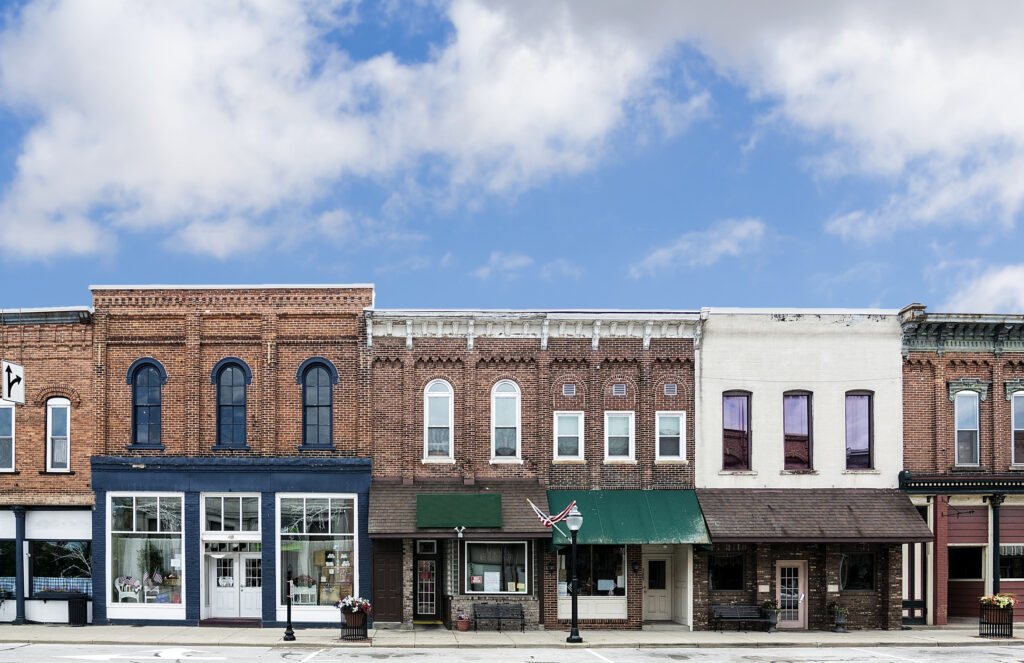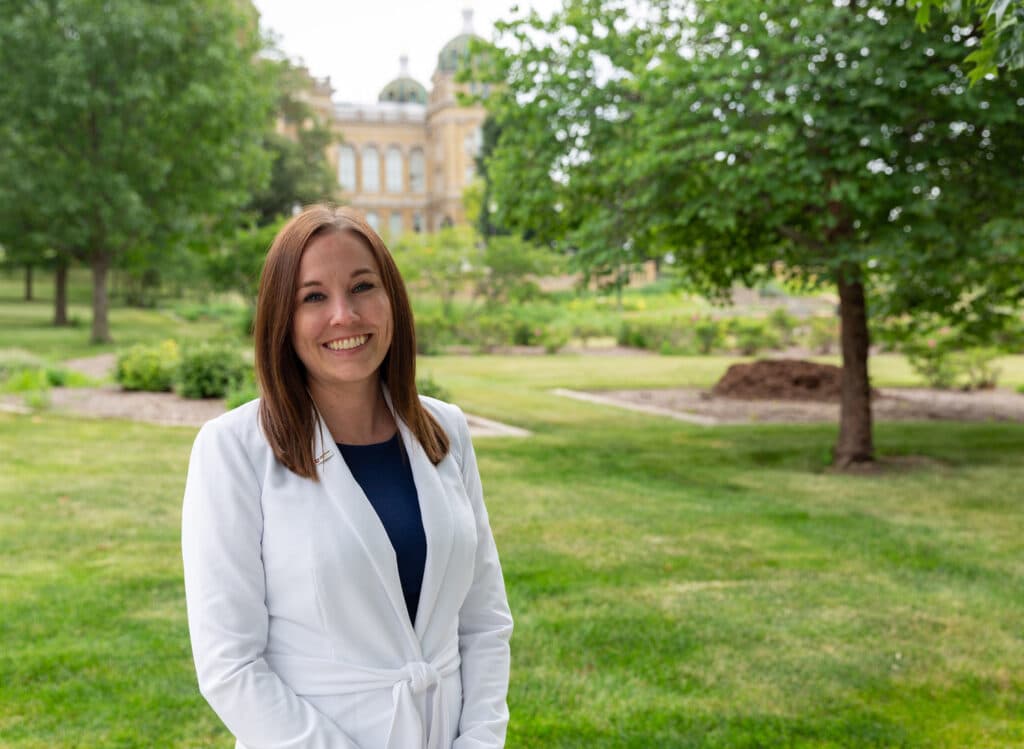10 takeaways: Disruption-proofing Des Moines’ economy

BUSINESS RECORD STAFF Sep 15, 2020 | 9:43 pm
11 min read time
2,548 wordsBusiness Record Insider, Economic Development
Mineck: Disruption brings a magnifying glass to the deep problems at work in communities
Mineck’s comments reminded me of the idea of wicked problems. A “wicked problem,” for those unfamiliar, is defined by the Stanford Social Innovation Review as a social or cultural problem with layers of interconnected other problems: for instance, linking poverty to housing, education, health and so on.
“Many in our community have been working on issues such as poverty, racial bias, housing instability, mental health disparities for a very long time. This pandemic and racial injustice has put a magnifying glass on that, but that doesn’t take away this level of exhaustion that people are coming into this time of urgency with,” Mineck said. “The wear and tear on many of our leaders and in our community is significant.”
Overlaying the specific challenges that a pandemic brings to an already layered regional economy — which already struggled with accessible housing, racial equity, developing resilient mental health services and building a larger workforce — can push community resources, and the people guiding them, to exhaustion.
“Desperate times either foster isolation or they foster connection,” Mineck said. “Coming together is only possible when there are relationships and networks of authentic trust.”
— Kate Hayden, staff writer
Child care and early education key to resiliency
I asked Mineck what public health factors we should be planning for, considering that some disease experts predict more future health crises because of our global economy. Her answer surprised me.
While there’s a lot of uncertainty about whether pandemics will become more common, she said child care and early education solutions are key to the region’s resiliency during disruptions. It’s an issue for policymakers, workplaces and nonprofits alike. Her comment reminded me of a quote in one part of a series we did on gender and family issues magnified by the pandemic.
“Current conditions separate us from our ‘village’ … teachers, school lunches, coaches, nanny, grandparents, house cleaning,” one respondent noted to us in our survey for the series. “We have realized just how much we relied on our ‘village’ for the fragile work-life balance we had struck pre-pandemic. Additionally, there is a range of loss that is experienced by each of us. Finding the time and the space to keep tabs on the emotions that surround all of the sudden change is challenging, too. Essentially, every need for our family of five has fallen to my husband and me — there is increased gratitude for the prior support network.”
The challenges with child care and home schooling, albeit different depending on the circumstances, have been obvious for both essential workers and those working remotely.
— Emily Barske, associate editor
What does authentic outreach look like?
“I think authenticity comes when you are able to recognize what your goal is, and what another person’s goals are,” DeJear said. “If you can get to that point, I think authenticity is beginning, because if you are intentional about adding value, then that means you must understand another person’s walk. If you are intentional about resolving a problem, that means you must understand what that problem looks like. And I think with that understanding comes authenticity — the desire to understand something that may be outside of your bubble, the desire to understand someone that you may never, ever connect with but you may be skilled enough to help resolve their problem.
And there is another important attribute that leaders should be thinking about in addition to authenticity, Mineck said.
“I think the lesson we absolutely should be learning right now, if we haven’t already, is the role that humility plays in this time and place,” Mineck said. “To be vulnerable to what it is we don’t know, and to ask for help. To be honest with one another about where those gaps, those misses exist in our community, where we have ignored or buried voices.”
Mineck said that in a recent conversation she had, the idea of building the capacity of leaders who are closest to the challenge came up. Des Moines already has informal, powerful networks across its neighborhoods that it can tap into.
“I think informal networks, those grassroots leaders, are going to be the key to whether we move through to a more powerful, positive space for this community,” she said.
— Joe Gardyasz, senior staff writer
The ‘great reset’: An opportunity to refocus our future
If you talk to business leaders about how Des Moines is adapting to the coronavirus pandemic and the changes it has brought about for how businesses operate, you’re likely to hear the term the “great reset.”
And to get there, the community needs to embrace the weaknesses the pandemic has exposed, and work to build trust communitywide, according to panelists.
Byers raised the topic of the “great reset,” saying events of the past year, from the pandemic to the issue of racial equity, have created an opportunity to “create a better normal.”
“With disruption comes great challenges, but also great opportunity,” Byers said. “If you think about innovation, innovation is all about disruption, so disruption doesn’t have to be a bad thing. I would say embracing disruption and innovation is a big part of what we’re doing moving forward.”
While Des Moines entered the past year strong, outperforming regional cities like Minneapolis, Chicago and Kansas City, there’s still work still to be done, Byers said.
“We have an opportunity in 2021 to pull together as a region and really define what that future looks like for all of us,” he said. “What can we do with that ‘better normal?’ What can we do better in terms of sustainability? What can we do better in terms of being more inclusive? What can we do better in terms of being more resilient, and what can we do better in terms of embracing disruption and focusing on innovation moving forward?”
Christensen said challenges of the past year have created opportunities to reset the community’s goals and vision, “and make sure we’re aiming for the right thing.”
“I think pressure highlights places where you have weaknesses, and I think that’s what all these impacts have shown, is where we have weaknesses and opportunities to really grow as a region,” he said.
Mineck said that reset can only happen if greater trust is built communitywide.
“I think we need to be clear with ourselves and with one another that there are many in our community for whom that trust has been broken, repeatedly, perhaps. And so as we look to rebuild … care and attention must be made to authentically building trust across our community and engaging deeply across our community. That is what’s going to foster resilience. That is what will foster a better normal, a truer normal, and allow us to really get busy and address these deep issues that have long existed, and then it’s time for them to be resolved.”
— Michael Crumb, senior staff writer
Fragility of downtown: Post-pandemic future of downtowns hinges on return to work, restaurants and community connections
How resilient is downtown Des Moines?
With downtown office buildings sitting predominantly empty as employees work from home, and as cultural and recreation events are canceled, the question was asked: How much investment should take place in a downtown if nobody goes there?
Feehan said once a safe vaccine is available, more people will begin to visit downtown as events resume, but he warned that downtowns could face some long-term challenges as a result of the pandemic.
“There’s a lot of creative people coming up with new ways to gather and meet, but at the same time, we’re expecting nationwide a loss of 40-50% of the restaurants in our downtowns, and that’s going to have a big impact,” Feehan said. “One of the reasons people want to be downtown is because of the dining options, entertainment options and everything.”
Feehan said that while the regional economy may rebound quickly, “the downtowns are more fragile than any of us thought.”
Christensen said that while office buildings may be mostly vacant right now, there are tentacles connecting downtown to the rest of the community.
“If you drive by the sculpture park, or walk through the East Village, there’s still a sense of the center that is important,” he said. “Planning efforts need to realize how downtown is a collection of buildings, the infrastructure, the people and the nature and the heart. It’s the whole fabric that makes a downtown.
“We have something special,” Christensen said. “Embracing our neighborhoods and having them connect to downtown long-term is going to help us ride out the ups and downs of what the pandemic is doing to us currently.”
Byers said he thinks downtown will come back fast.
He cited efforts to increase downtown housing — with 12,000 people now living downtown — as one factor that will help bring downtown back faster than in some cities.
Byers also said Des Moines’ economy, revolving around insurance and finance, is more recession-proof. He cited the adaptability of the business community to working remotely, and the cohesiveness of the relationships that were built prior to the pandemic as other factors that will serve downtown Des Moines well.
“We do have a lot of these factors moving forward, but I do think, in terms of downtown employment, that will come back and I think it will come back fast,” Byers said.
DeJear said the human-to-human connection is critical, and despite current trends toward remote working, it needs to be prioritized moving forward.
— Michael Crumb, senior staff writer
Fatigue is setting in. How do we get through it?
A growing number of people these days are feeling worn out, beaten down and just plain exhausted, DeJear said.
The pandemic, social unrest and the derecho have everyone fatigued, DeJear said.
“We know fatigue is inevitable,” she said. “But regardless of it, how do we get through it? … How do we set up our employees in such a way that they can overcome that fatigue? How does our leadership ensure that they are best prepared to lead their staffs and their employees in the midst of fatigue?”
Business leaders and others need to share with their peers ways they are overcoming fatigue, DeJear said. “We’re all experiencing fatigue. There’s a way to get through it; there’s a way to get over it. … We need to work together to do it.”
— Kathy A. Bolten, senior staff writer
The difference between ignorance and close-mindedness
In talking about inclusion efforts, Christensen said, “It’s OK to not know, it’s not OK to not want to know.” I really liked that comment because it applies to so many things, including how our privilege may get in the way of understanding others and how we may not naturally understand situations if we don’t have lived experience.
It’s always interesting how people can hear the same thing, but it could provoke entirely different thoughts. During the networking portion of the event after the panel, Mineck mentioned that understanding mental health was one of the things that came to mind when she heard Christensen say that. One of my immediate thoughts after hearing it was “That’s why being an active news consumer is so important.” We don’t know what we don’t know, and unless we continually seek to understand and learn about others’ challenges, we can’t grow together as a community.
— Emily Barske, associate editor
Past investment in housing, human connection continue to give back in uncertain times
Why should communities continue to invest in spaces that may not be used in the same way
post-pandemic?
Because human connection is worth prioritizing, DeJear said.
“Human connection is critical. It’s a basic necessity that I think we sometimes undermine the importance of,” DeJear said. “While trends may be showing us that things are going in this direction or that direction, it’s important sometimes for us to interrupt the trends to prioritize what’s necessary for us. Human-to-human connection is necessary for us, not only in understanding each other, but it’s important as it relates to us growing and becoming stronger.”
“Despite all odds, despite all trends, despite where the waves are going, we need to hold on to the importance of human connection in our planning processes,” she added.
The growth of housing in and around downtown Des Moines over the last few years has anchored a population downtown to help small businesses and restaurants stay resilient during the COVID-19 shutdown, despite offices remaining empty in favor of work-from-home policies, Byers said.
“Creative collisions matter,” he said. “The big trend before this was all about interaction and creative collisions. … I do think the office, in terms of downtown employment, is going to come back.”
— Kate Hayden, staff writer
Making the best of a crisis
Winston Churchill, toward the end of World War II, is credited with first saying, “Never let a good crisis go to waste.”
The line has been repeated often since the mid-1940s and has been said frequently during the pandemic.
Christensen was asked what opportunities there were to make improvements in the Des Moines area during the current crisis.
He cited two things: inclusion and embracing nature.
The social unrest occurring throughout the country is an opportunity to bring previously unheard voices to the table to help plan future projects, Christensen said. “We really have to figure out how to move the ball forward. Getting stakeholders – and new stakeholders that have not previously been engaged in planning efforts – is going to be key.”
Additionally, at the beginning of the pandemic, many people began walking on the sidewalks of their neighborhoods, he said.
“Des Moines has great infrastructure of natural amenities,” Christensen said, using the water trail project as an example. But Des Moines can also do more to “integrate all of our neighborhoods so that we have a much more cohesive and less isolated city.”
— Kathy A. Bolten, senior staff writer
Increasing connectivity through broadband
Byers said he believes there are significant opportunities for increasing inclusion in Greater Des Moines, and cited a current initiative that will help toward that goal.
“I think there are lots and lots of leaders in this community that want to be a lot more engaged and a lot more helpful, and they’re looking for sort of a playbook in terms of what we can do, and how do we do that,” he said. “I think we really need to leverage that opportunity to do something really, really big for inclusion and let that process work out.”
In terms of lessons learned about existing gaps, improving broadband connectivity is a significant piece of the Partnership’s 18-month strategic plan, he said.
“We’re putting together a big regional analysis in terms of what is our coverage in the 10- to 12-county region. [It’s looking at] that gap analysis, and what do we need to do moving forward to significantly increase connectivity, both in terms of service but also accessibility,” Byers said. “Because we know there are a lot of gaps out there, whether it’s for remote working, for startups, for education or for telehealth. To be best in class with broadband is a competitive edge that we need to move forward.”
— Joe Gardyasz, senior staff writer









